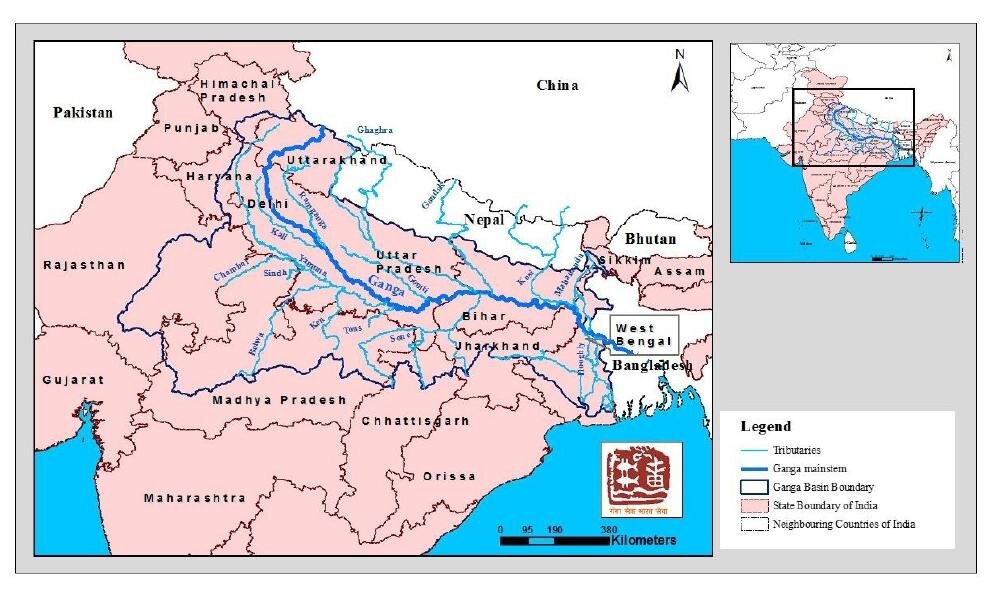Governance
Ganga Utsav 2020
- 03 Nov 2020
- 5 min read
Why in News
Recently, the Ganga Utsav 2020 has begun which celebrates the glory of the National river Ganga.
- Ganga was declared as the National River of India on 4th November 2008.
Key Points
- Ganga Utsav:
- The National Mission for Clean Ganga (NMCG) celebrates the festival every year.
- NMCG is the implementation wing of National Ganga Council, set up in 2016, which replaced the National Ganga River Basin Authority (NRGBA).
- The three-day festival aims to promote stakeholder engagement and ensure public participation.
- It celebrates mystical and cultural river Ganga through storytelling, folklores, dialogues with eminent personalities, quizzes, displaying traditional art forms, dance and music performance by renowned artists, photo galleries and exhibitions and much more.
- The National Mission for Clean Ganga (NMCG) celebrates the festival every year.
- Programmes Held During the Festival:
- Ganga Task Force (GTF) conducted an afforestation drive with National Cadet Corps (NCC) cadets and educational tour for youth.
- GTF is a unit of battalion of ex-servicemen deployed in the services of the Ganga with the approval of the Ministry of Defence for the period of four years till December 2020.
- It was approved by the Cabinet under the Public Participation component of the Namami Gange Programme and the first battalion was raised in March 2016.
- Mini Ganga Quest, designed to make youth and students aware of environmental issues and explain their role in conservation.
- Ganga Quest is a pan India bilingual quiz to increase public participation in Namami Gange program and encourage the youth.
- Suggestion on the innovative ways in which Namami Gange can engage in activities throughout the year.
- In 2014, Namami Gange Programme was launched to accomplish the twin objectives of effective abatement of pollution and conservation, and rejuvenation of Ganga.
- Ganga Task Force (GTF) conducted an afforestation drive with National Cadet Corps (NCC) cadets and educational tour for youth.
- Government Initiatives on River Ganga:
- Ganga Action Plan: It was the first river action plan which was taken up by the Ministry of Environment, Forest and Climate Change in 1985, to improve the water quality by the interception, diversion and treatment of domestic sewage.
- The National River Conservation Plan is an extension to this plan, which aims at cleaning the Ganga river under Ganga Action Plan phase-2.
- National River Ganga Basin Authority: It was formed by the Government of India in the year 2009 under Section-3 of the Environment Protection Act 1986.
- Clean Ganga Fund: In 2014, it was formed for cleaning up of the Ganga, setting up of waste treatment plants and conservation of biotic diversity of the river.
- Bhuvan-Ganga Web App: It ensures the involvement of the public in the monitoring of pollution entering into the river Ganga.
- Ban on Waste Disposal: In 2017, the National Green Tribunal (NGT) banned the disposal of any waste in the Ganga.
- Ganga Action Plan: It was the first river action plan which was taken up by the Ministry of Environment, Forest and Climate Change in 1985, to improve the water quality by the interception, diversion and treatment of domestic sewage.
River Ganga
- It is the longest river of India flowing over 2,510 km of mountains, valleys and plains and is revered by Hindus as the most sacred river on earth.
- It originates in the snowfields of the Gangotri Glacier in the Himalayas as the Bhagirathi River and is joined by other rivers such as the Alaknanda, Yamuna, Son, Gumti, Kosi and Ghagra.
- The Ganga river basin is one of the most fertile and densely populated areas of the world and covers an area of 1,000,000 sq. km.
- The Ganges River Dolphin is an endangered animal that specifically habitats this river.
- The Ganga widens out into the Ganges Delta in the Sundarbans swamp of Bangladesh, before it ends its journey by emptying into the Bay of Bengal.





